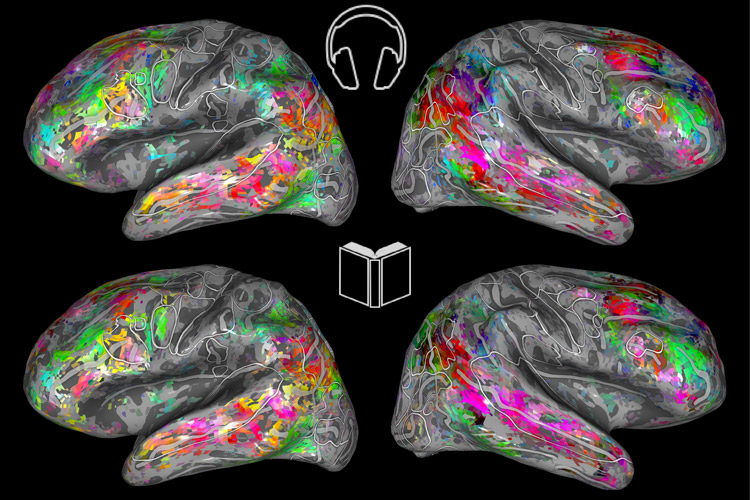Which Part of the Brain Deals With Reading

Besides busy or lazy to read Melville'sMoby Dick or Tolstoy'sAnna Karenina? That'south OK. Whether you read the classics, or listen to them instead, the same cognitive and emotional parts of the brain are probable to be stimulated. And now, there's a map to prove information technology.
UC Berkeley neuroscientists have created interactive maps that can predict where different categories of words actuate the encephalon. Their latest map is focused on what happens in the encephalon when yous read stories.
Opening the door to inner narratives
The findings, actualization today (Aug. 19) in theJournal of Neuroscience, provide farther evidence that different people share similar semantic — or give-and-take-significant — topography, opening yet another door to our inner thoughts and narratives. They likewise take practical implications for learning and for speech disorders, from dyslexia to aphasia.
"At a fourth dimension when more people are arresting data via audiobooks, podcasts and even audio texts, our report shows that, whether they're listening to or reading the same materials, they are processing semantic information similarly," said report lead author Fatma Deniz, a postdoctoral researcher in neuroscience in the Gallant Lab at UC Berkeley and former young man with the Berkeley Establish for Data Science.
For this latest brain mapping study, people listened to stories from "The Moth Radio 60 minutes," a popular podcast series, and so read those aforementioned stories. Using functional MRI, researchers scanned their brains in both the listening and reading weather condition, compared their listening-versus-reading brain activity data, and plant the maps they created from both datasets were nigh identical.
The results tin be viewed in an interactive, 3D, color-coded map, where words — grouped in such categories as visual, tactile, numeric, locational, violent, mental, emotional and social — are presented like vibrant butterflies on flattened cortices. The cortex is the coiled surface layer of gray affair of the cerebrum that coordinates sensory and motor information.
The interactive 3D brain viewer is scheduled to get online this week.
As for clinical applications, the maps could be used to compare language processing in healthy people and in those with stroke, epilepsy and encephalon injuries that impair speech. Understanding such differences can assist recovery efforts, Deniz said.
Decoding the dyslexic brain
The semantic maps can also inform interventions for dyslexia, a widespread, neurodevelopmental language-processing disorder that impairs reading.
"If, in the future, we observe that the dyslexic brain has rich semantic language representation when listening to an audiobook or other recording, that could bring more audio materials into the classroom," Deniz said.
And the same goes for auditory processing disorders, in which people cannot distinguish the sounds or "phonemes" that make upwardly words. "Information technology would be very helpful to exist able to compare the listening and reading semantic maps for people with auditory processing disorder," she said.
9 volunteers each spent a couple of hours inside functional MRI scanners, listening so reading stories from "The Moth Radio Hour" as researchers measured their cerebral blood flow.
Their encephalon action data, in both conditions, were then matched confronting fourth dimension-coded transcriptions of the stories, the results of which were fed into a computer program that scores words according to their relationship to 1 another.
The mind's thesaurus
Using statistical modeling, researchers arranged thousands of words on maps according to their semantic relationships. Under the animals category, for case, 1 tin find the words "bear," "cat" and "fish."
The maps, which covered at least one-3rd of the cerebral cortex, enabled the researchers to predict with accuracy which words would activate which parts of the encephalon.
The results of the reading experiment came as a surprise to Deniz, who had predictable some changes in the style readers versus listeners would procedure semantic data.
"We knew that a few brain regions were activated similarly when you hear a word and read the same word, merely I was not expecting such strong similarities in the meaning representation beyond a large network of encephalon regions in both these sensory modalities," Deniz said.
Her study is a follow-up to a 2016 Gallant Lab report that recorded the encephalon activity of seven written report subjects as they listened to stories from "The Moth Radio Hour." That online encephalon viewer tin be establish hither.
Future mapping of semantic data volition include experiments with people who speak languages other than English, as well as with people who have language-based learning disorders, Deniz said.
Co-authors of the study are Anwar Nunez-Elizalde, Alexander Huth and Jack Gallant, all of UC Berkeley.
Come across ALSO:
Study inThe Journal of Neuroscience
Scientists map brain's thesaurus to aid decode inner thoughts
Scientists apply encephalon imaging to reveal the movies in our mind
Scientists construct outset map of how the brain organizes everything we see
Source: https://vcresearch.berkeley.edu/news/map-brain-can-tell-what-youre-reading-about
0 Response to "Which Part of the Brain Deals With Reading"
Post a Comment